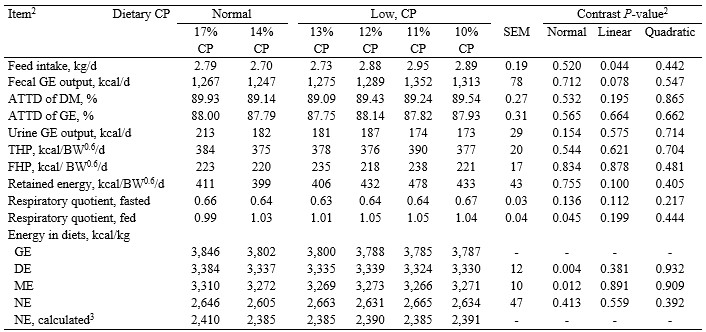
Soybean meal (SBM) is the major source of amino acids (AA) and energy in diets for swine throughout the world because SBM has an AA profile that matches the requirements of pigs and AA in SBM have high digestibility. In the U.S., nearly 20% of all SBM produced is used to feed pigs. However, AA in diets can also be provided by feed-grade synthetic AA and diets based on corn and synthetic AA have been thought to also increase diet net energy and reduce N excretion and carbon footprint. With the addition of synthetic AA in diets, it is possible to reduce the inclusion of SBM and formulate diets with reduced crude protein. However, recent data indicate that pigs of modern genotypes utilize more dietary protein than older genotypes and the net energy may, therefore, not be increased in diets that contain less SBM and more corn and synthetic AA. Therefore, the objective of this experiment was to test the hypothesis that diets based on corn and SBM and limited quantities of synthetic AA contain net energy that is not different from diets based on corn and larger quantities of synthetic AA.
Experimental design
Six diets were formulated. The first diet contained corn, SBM, and no synthetic AA. The second diet was similar to a typical commercial diet containing corn, SBM, synthetic Lys, Met, and Thr. Four additional diets had reduced protein of 1, 2, 3, or 4% units compared with the second diet. All diets also contained vitamins and minerals to meet the current requirements for pigs (NRC, 2012).
A total of 24 growing pigs (initial BW: 29.9 ± 2.4 kg) were housed in 6 indirect calorimeter chambers and allotted to the 6 diets using a replicated 6 × 6 complete Latin square design with 6 chambers, 6 periods, and 6 diets. Thus, there were 6 replicate chambers per diet in the experiment. Pigs were housed in groups of 4 pigs per chamber. Each chamber was equipped with a stainless steel wet-dry feeder, and an auxiliary nipple waterer was installed in each chamber to ensure free access to water. Each chamber was also equipped with a slatted floor, 4 stainless steel fecal screens, and 2 urine pans for a total, but separate, collection of fecal and urine materials. The temperature and relative humidity inside the chambers were controlled and maintained at the same level in all chambers.
Throughout the experiment, pigs were allowed ad libitum access to feed. Diets were fed for 13 d, where the initial 7 d were considered the adaptation period to the diet followed by 6 d of total collection of feces and urine. Total heat production (THP) was calculated using analyzed O2 consumption and CO2 and CH4 productions. Fasting heat production (FHP) was also measured. Concentrations of digestible energy, metabolizable energy, net energy, and apparent total tract digestibility (ATTD) of gross energy in diets were calculated.
Results
Results indicated that feed intake, fecal and urine GE output, ATTD of dry matter and gross energy as well as THP, FHP, and retained energy were not different among pigs fed diets containing 17 or 14% crude protein, but the respiratory quotient of pigs fed the 17% diet was less (P = 0.045) compared with the 14% CP diet. Digestible energy and metabolizable energy in the 17% diet was greater (P < 0.05) than in the 14% diet, but net energy was not different between these 2 diets. Feed intake, gross energy intake, and fecal energy output of pigs linearly (P = 0.044) increased by reducing crude protein in diets but reducing diet crude protein did not affect total tract digestibility of dry matter or gross energy or excretion of gross energy in the urine. Total heat production, FHP, retained energy, and digestible, metabolizable and net energy were also not affected by reducing crude protein in diets from 14 to 10%.
The calculated net energy in diets based on net energy for corn and SBM from previously reported values (NRC, 2012) increased almost 100 kcal/kg as SBM inclusion was reduced and corn inclusion increased, however, but results of the experiment demonstrated that there was no effect on net energy of reducing SBM and increasing corn in the diets. These observations indicate that the net energy in SBM likely is close to the net energy in corn, which likely is a result of increased utilization of protein in modern genotypes of pigs compared with older genotypes. There is therefore a need for updating the net energy value for SBM when formulating diets for pigs.
Key points
- The diet based on corn and SBM and no synthetic AA had greater digestible and metabolizable energy than diets with reduced SBM and synthetic AA.
- Reducing SBM and supplementing with synthetic AA did not affect net energy in diets.
- The net energy in all diets obtained in the experiment was greater than calculated net energy using NRC (2012) equations.
- Results indicate that net energy in SBM is greater than previously thought and close to net energy in corn.
Table 2. Effects of reducing crude protein (CP) on apparent total tract digestibility (ATTD) of dry matter (DM) and gross energy (GE) and concentrations of digestible energy (DE), metabolizable energy (ME), and net energy (NE) in diets and total heat production (THP) and fasting heat production (FHP), one-pig basis1

1Each least squares mean represents 6 observations.
2Normal = 17% CP diet vs. 14% CP diet; linear = linear effects of reducing dietary protein from 14% to 10%; quadratic = quadratic effects of reducing dietary protein from 14% to 10%.
3Calculated from NRC (NRC, 2012).





